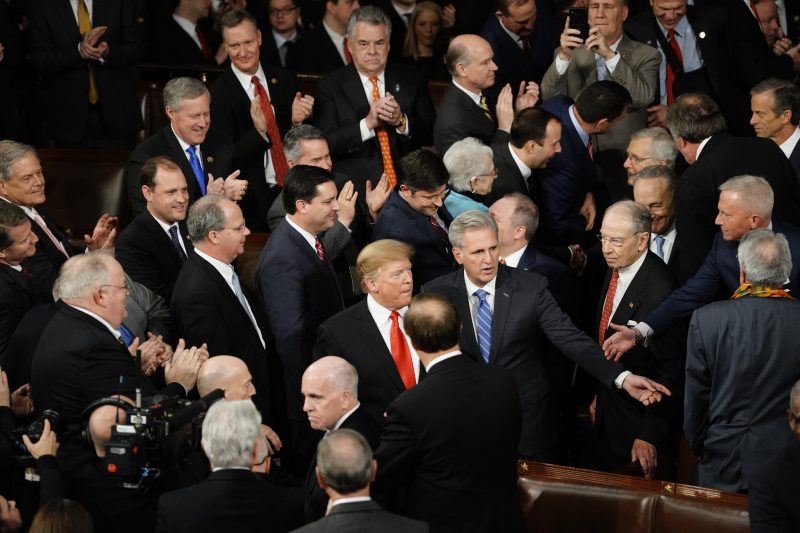Former House speaker Kevin McCarthy (R-Calif.), involuntarily unshackled from responsibility for the Republican conference, has taken to offering his unvarnished thoughts on a range of things, from Rep. Matt Gaetz (R-Fla.) to American politics broadly to the elected officials he dislikes the most, like Rep. Matt Gaetz.
On Wednesday, this truth tour brought him to the New York Times’s DealBook event, where he discussed his party and politics with interviewer Andrew Ross Sorkin. McCarthy was hyping his success rate as his party’s leader from 2019 until a few months ago — gaining seats in 2020 and 2022 — when he articulated an unexpected electoral priority.
“I became leader when we took the minority, and this was a turning point for me,” McCarthy said, describing having attended the 2019 State of the Union address.
“I’d just become leader and I’m excited and President Trump’s there. And I look over at the Democrats and they stand up. They look like America,” he told Sorkin. “We stand up. We look like the most restrictive country club in America.”
According to McCarthy, it was at that moment that he decided he was either “going to be the leader of a declining end of a party or I have to change the opportunity in this party.” He told Sorkin that diversifying the party’s presence meant ensuring that more women and non-White candidates won Republican primaries (since “the November election is not their tough election”), so he took a more active role in influencing primary outcomes.
This is an unexpected admission! It’s not uncommon for Democrats to note that their party better reflects America’s diversity or that the Republican Party looks like a country club, but it is uncommon for the former head of the House Republican Party to do so. That the party has struggled to appeal to non-White voters and women is well-established; in the wake of the 2012 presidential election, there was a brief push to expand the party’s appeal. But then Trump won the 2016 nomination by focusing heavily on White grievance and that push for diversity was largely abandoned … until the party underperformed in 2022.
That said, McCarthy’s rhetoric isn’t isolated. Trump’s better-than-normal performance with non-White voters in 2020 and the apparent continuation of that trend last year has many on the right seeing a new opportunity that mirrors McCarthy’s description. But as a review of House demographics makes obvious, there’s a lot of work to do to change the visual impression that struck McCarthy in 2019.
DailyKos compiles regular analyses of the composition of the House. We pulled data for the last four new Congresses (that is, before anyone left or was elected into it) — the ones beginning in 2017, 2019, 2021 and 2023.
Those latter two are the ones that would presumably have been affected by McCarthy’s revelation. And, in fact, the Republican conference did get less densely White — at least a little.
As we wrote in 2016, the GOP is more diverse than it used to be, but less diverse than the Democratic Party was decades ago.
The same dynamic exists with gender: the Republican conference has a higher percentage of women than it used to, but it’s still well short of half and well short of the Democrats.
As it turns out, the 2019 group that struck McCarthy as particularly White and male was particularly White and male. Most Democrats in the House have been women or non-White for some time. Three-quarters of Republicans still are not.
One place where the GOP conference looks more like America is in its age distribution. Neither party has many legislators under the age of 40. But the Democrats have a higher density of legislators 65 or older.
The Republican conference in the House is in some ways less representative of the country than are Republicans more generally. Analysis of the 2022 General Social Survey (GSS), a national poll of social issues, shows that the gender split among Republicans (and Republican-leaning independents) is much closer to the overall divide than is seen in the House. About 9 in 10 Republicans (and leaners) were White in the GSS, about the same as the GOP caucus. Democrats (and leaning independents) are a bit closer to the overall diversity of the country.
It’s important to recognize that this discussion of “looking like America” necessarily means looking like adult America. Younger Americans are less likely to be White than older Americans, which holds true as age decreases. Even within the ranks of Republicans/leaners, youth correlates to racial diversity. Among Republicans/leaners over 65 in the GSS, 96 percent were White. Among those under the age of 40, only 85 percent were.
For some time — at least since 2012 but probably at least 2008 — a key question for Republicans has been how America’s increasing diversity would affect the party’s electoral prospects. The question remains unanswered. We now know that McCarthy somewhat belatedly came to the realization in 2019 that it was something worth addressing.

